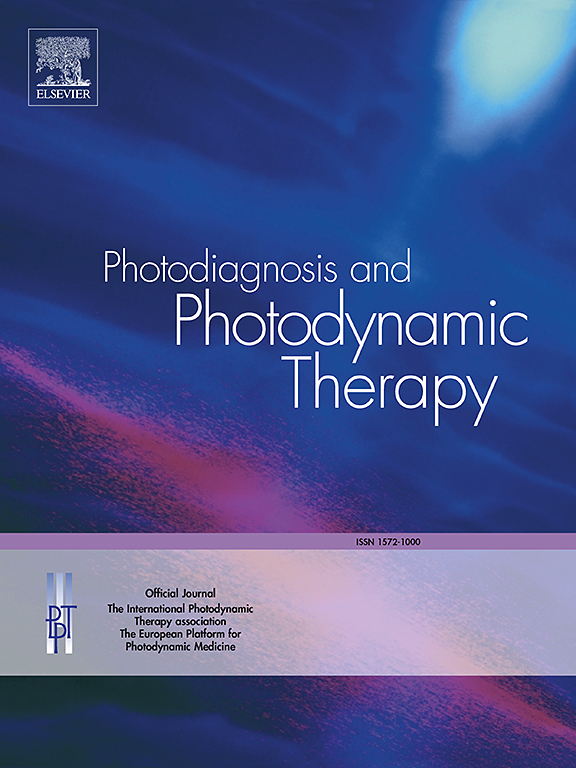New insights on antibacterial mode of action of blue-light photoactivated berberine and curcumin-antibiotic combinations against Staphylococcus aureus
IF 3.1
3区 医学
Q2 ONCOLOGY
引用次数: 0
Abstract
Antimicrobial photodynamic inactivation (aPDI), using photosensitisers in combination with antibiotics, is a promising multi-target strategy to address antibiotic resistance, particularly in wound infections. This study aimed to elucidate the antibacterial mode of action of combinations of berberine (Ber) or curcumin (Cur) with selected antibiotics (Ber-Ab or Cur-Ab) under blue light irradiation (420 nm) against Staphylococcus aureus, including methicillin-resistant (MRSA) and methicillin-susceptible (MSSA) strains. Multiple physiological parameters were assessed using complementary assays (fluorometry, epifluorescence microscopy, flame emission and atomic absorption spectroscopy, zeta potential, flow cytometry, and the plate agar method) to examine the effect on ROS production, membrane integrity, DNA damage, motility and virulence factors of S. aureus. Results indicated that blue light photoactivated Ber-Ab and Cur-Ab combinations led to substantial ROS generation, even at low concentrations, causing oxidative stress that severely impacted bacterial membrane integrity (approximately 90 % in MRSA and 40 % in MSSA). Membrane destabilization was further confirmed by elevated intercellular potassium release (≈ 2.00 and 2.40 µg/mL in MRSA and MSSA, respectively). Furthermore, significant DNA damage was observed in both strains (≈ 50 %). aPDI treatment with blue light also reduced S. aureus pathogenicity by impairing motility and inhibiting key virulence factors such as proteases, lipases, and gelatinases, all of which play key roles in the infectious process. Overall, Ber-Ab combinations demonstrated the highest efficacy across all parameters tested, highlighting for the first time the multi-target therapeutic potential of this phytochemical-based aPDI strategy to combat antibiotic-resistant S. aureus infections and improve wound infection treatment outcomes.

蓝光光活化小檗碱与姜黄素联合抗生素对金黄色葡萄球菌抗菌作用模式的新认识。
抗菌素光动力失活(aPDI),将光敏剂与抗生素联合使用,是解决抗生素耐药性的一种有前途的多靶点策略,特别是在伤口感染中。本研究旨在阐明小檗碱(Ber)或姜黄素(Cur)与选定的抗生素(Ber- ab或Cur- ab)在蓝光照射(420 nm)下联合对金黄色葡萄球菌(包括耐甲氧西林(MRSA)和甲氧西林敏感(MSSA)菌株的抑菌作用模式。采用互补检测(荧光法、表观荧光显微镜、火焰发射和原子吸收光谱、zeta电位、流式细胞术和平板琼脂法)评估多种生理参数,以检测对金黄色葡萄球菌ROS生成、膜完整性、DNA损伤、运动性和毒力因子的影响。结果表明,蓝光光激活的Ber-Ab和Cur-Ab组合即使在低浓度下也会产生大量ROS,导致氧化应激,严重影响细菌膜的完整性(MRSA约为90%,MSSA约为40%)。细胞间钾释放升高(MRSA和MSSA分别≈2.00µg/mL和2.40µg/mL)进一步证实了膜的不稳定性。此外,在两株中均观察到显著的DNA损伤(≈50%)。蓝光aPDI治疗还通过损害运动和抑制关键毒力因子(如蛋白酶、脂肪酶和明胶酶)来降低金黄色葡萄球菌的致病性,这些毒力因子在感染过程中都起着关键作用。总体而言,Ber-Ab组合在所有测试参数中显示出最高的疗效,首次突出了这种基于植物化学物质的aPDI策略在对抗耐抗生素金黄色葡萄球菌感染和改善伤口感染治疗结果方面的多靶点治疗潜力。
本文章由计算机程序翻译,如有差异,请以英文原文为准。
求助全文
约1分钟内获得全文
求助全文
来源期刊

Photodiagnosis and Photodynamic Therapy
ONCOLOGY-
CiteScore
5.80
自引率
24.20%
发文量
509
审稿时长
50 days
期刊介绍:
Photodiagnosis and Photodynamic Therapy is an international journal for the dissemination of scientific knowledge and clinical developments of Photodiagnosis and Photodynamic Therapy in all medical specialties. The journal publishes original articles, review articles, case presentations, "how-to-do-it" articles, Letters to the Editor, short communications and relevant images with short descriptions. All submitted material is subject to a strict peer-review process.
 求助内容:
求助内容: 应助结果提醒方式:
应助结果提醒方式:


